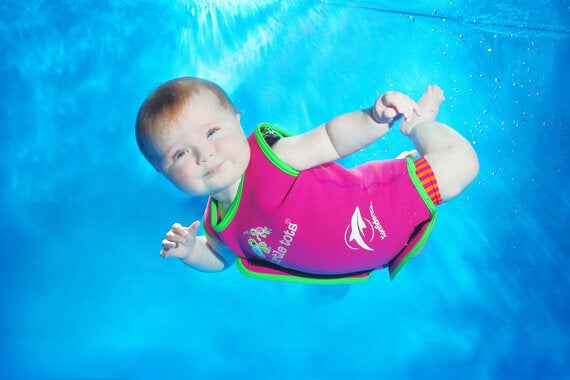According to the RLSS UK (Royal Life Saving Society), around 400 people needlessly die from drowning in the UK every year and thousands more suffer water-related injuries or some life-changing near-drowning experience. Putting these figures into context, one person dies every 20 hours in the UK and drowning is the leading cause of accidental death of children in the UK.
This week is National Drowning Prevention Week (18 - 26 June 2016) so it's the perfect time to raise awareness of the importance of keeping your child safe around the water this summer. As the summer months go by, many of us will soon jet off to sunny destinations lured by the promise of turquoise seas and days spent relaxing by the pool, so it's important to be aware of the very real danger of water and to take the necessary precautions to keep your children safe.
Of course, all parents want to do everything they can to prevent drowning-related incidents but there are also many things you can do to build water confidence in your child during the earliest years of their life and long before they can actually swim. Teaching your child to be safe around water from a young age is also about building on the instincts they are born with.
Learning to swim as young as possible is just one of the elements of building confidence around water, but even long before a child can swim independently on the surface of the water there are things that they can learn to do which will greatly reduce the risk of drowning.
Just teaching your child to safely submerge from the water means they are far less likely to panic if they ever accidently fall into deep water. Panic unfortunately causes a sharp intake of breath, filling the lungs with water in seconds and it's this knee-jerk reaction that we want to take control of early on. Even young babies can learn to hold their breath as a response to going under water but it is about familiarity with the water and regular practice.
Teaching your child to turn around in the water and to hold on to the side of the pool is also a great idea because this will become an instinctive response as soon as they come into the water.
The vast majority of drowning-related incidents that happen in the 0-5 years age group happen right by the waters edge, because children do not know how to save themselves. So it is this skill set that we should work on alongside the physical act of learning to swim.
Building water confidence is vital because unless children become familiar with water in their early years it may be many, many years before they learn to swim, increasing their potential risk of drowning. Children under 18 months generally have no fear of water whatsoever, but this can quickly develop in toddlers who have not been introduced to the water early on and can in some cases, take many years to overcome.
Top Tips for keeping your child safe around water:
1. Take your child to the swimming pool regularly and perhaps consider attending some professional baby swim classes to learn how to safely submerge your baby so that they can practice this over the summer.
2. Teach your children never to enter the water without an adult present. It is very easy for them to lose balance, slip and fall into the water.
3. Ensure that any 'jumping in' is done safely from the side of the pool and under adult supervision.
4. Always make sure your children never run on the poolside for obvious reason.
5. Use a floatation aid on holiday to give you as a parent a chance to relax, we recommend the SwimFin.
6. If your child accidently falls into water and cannot swim then enter the water safely and quickly to assist them. Throw in a floating object for them to hold on to if one is available. Try not to panic (easier said than done of course), for safety reasons remove shoes and loose clothing before entering water if you are able to.
7. Sadly many children drown on holiday in a non-lifeguarded pool, as previously explained this can happen right by the water's edge and in a matter of seconds. Never leave your child unattended near water for any amount of time, however short.
8. Ensure the pool area is inaccessible to prevent toddlers from wandering out by themselves.
To enjoy water safely and to reduce the risk of drowning, teaching a healthy respect of the water is vital. Parents can help by demonstrating safe behaviour around water, going swimming regularly and reinforcing the safety rules that should live with your child now and in years to come.
